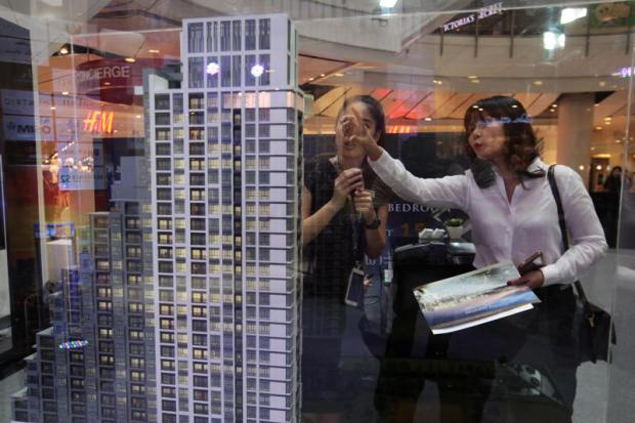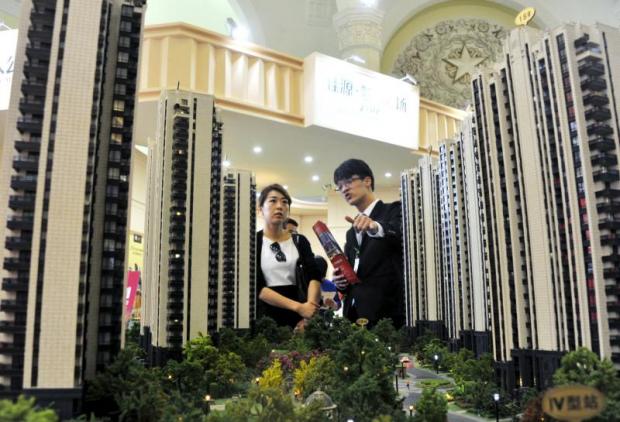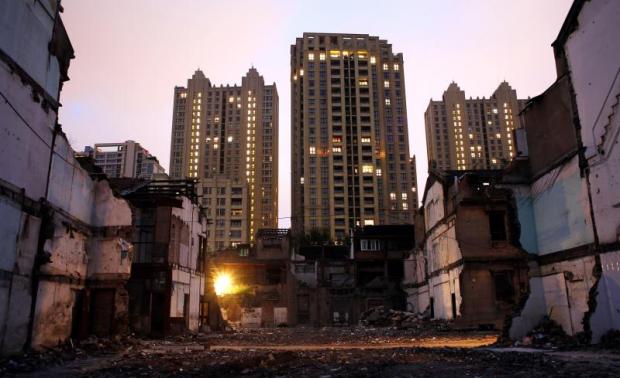Bubble trouble
Prices are still rising at the top end but Bangkok appears to be joining the ranks of other Asian cities facing a worrying property glut.
- Published: 22 Jun 2015 at 03:30 1 comments
- NEWSPAPER SECTION: Asia focus | WRITER: Fan Ching Yu and Niramol Thongpan

A woman examines a model of a luxury condominium at a recent fair in Bangkok.
The slowing economy coupled with a lack of liquidity in the system could be leading Bangkok to join some other major Asian cities that are facing a property glut as demand starts to show signs of cooling.
Thailand's property sector has been perceived to be on a never-ending up cycle for more than a decade by developers, investors and speculators alike. Even events such as the 2006 coup, the 2007-08 global financial crisis and the political unrest of 2014 have been relative blips where the confidence of property buyers was concerned.
However, supply and inventory levels of late have been on a continued rise and take-up is slowing, reflecting in part a buildup of high household debt nationwide as well as weak confidence in the overall economy. According to the available data, the current inventory in the capital region is sufficient to last at least another two years at the current take-up rate.
The inventory figure for Bangkok is similar to those seen in major cities in China, where statistics show levels ranging between 12 and 33 months for residential property as of the end of last year — the highest since the property bubble emerged in China a few years ago.
Major cities in India are also experiencing a property bubble. The most extreme case can be seen in Mumbai, where demand for high-end housing priced above 50 million rupees (26.5 million baht) remains low and the inventory of unsold luxury housing now stands at 100 months, according to Pankaj Kapoor, the founder of the real estate research group Liases Foras.
A "healthy market" normally maintains about eight months of inventory, Bloomberg recently quoted Mr Kapoor as saying.
Singapore earlier in this decade was also experiencing property price inflation to the point where many local residents were being priced out of the market. However, prices have been cooling for the past six quarters as government measures to discourage speculation take hold. These have included higher loan-to-value ratios that banks must follow when lending mortgages, as well as increased stamp duty rates for both buyers and sellers.
Prices of property from China to Singapore, Mumbai and New Delhi are now on a downward trend as their markets consolidate and regroup. But Thailand has yet to witness a slowdown. In fact, a new Sansiri Plc luxury condominium planned for Wireless Road in Bangkok's central business district is expected to shatter local records with prices starting at 400,000 baht per square metre. That's about 50,000 baht above the current record, although some resale prices reportedly have been higher.
"We will launch the project on Wireless which will push per-square-metre prices to new levels," Sansiri president Srettha Thavisin told Asia Focus.
He believes the high-end market remains vibrant despite continued talk of a slowdown, and expresses confidence that the 77 units priced at 100 million baht each will be sold out in no time.
While Sansiri has had notable success with recent projects including The Link, a joint venture with BTS Holding Plc, many developers are facing much tougher conditions.
Four projects launched over the past fortnight by three other large SET-listed developers — LPN Development Plc, Pruksa Real Estate Development Plc and Supalai Plc — had take-up rates under 50%, well below the expectations of the developers.
Market veteran Anant Asavabhokin, the largest shareholer of the residential development giant Land & Houses, has openly stated that he sees the market heading for an oversupply, especially the condominium sector.
He has described the situation as especially critical in the medium-priced market where there has been a lot of speculation.
Even Sansiri acknowledges that some segments of the market are oversupplied, as does LPN, which has a long track record of success in marketing budget and medium-priced condominiums.
"We do see a situation of oversupply but in some specific locations and in some segments, especially the locations that are very close to the mass-transit lines, and more in the medium-priced segment," LPN executive director Yupa Techakraisri told Asia Focus in an e-mailed response.

"We are focusing more on affordable products which are in a different segment where the demand is still high."
Sansiri's Mr Srettha also admitted that there was some oversupply, noting that a lot of condominiums have been developed in anticipation of infrastructure, especially mass transit, that has yet to materialise. Many buyers have been reluctant to commit until they know for certain that construction will go ahead on all the new rail lines being promised across the capital.
Even LPN, known for its ability to accurately read demand in the "affordable" market, saw a take-up rate of only 39% against management expectations of 50-60% for Mixx, a new development in the Theparak-Srinakrin area of Bangkok's eastern suburbs.
Pruksa, meanwhile, saw take-up of only 20% for The Elegance in Tiwanon, despite its location only 800 metres away from a yet-to-open Purple Line mass-transit station.
In the central business district, the Elite Surawaong by Supalai recently offered 277 units but only 48% were booked at the project close to the Silom, Sathorn and Surawong area and within walking distance of mass transit.

INVENTORY PILING UP
According to data from Colliers International, the average take-up rate for all condominium units launched in Greater Bangkok from 2011 to 2014 was approximately 73%.
Applying that rate to the entire residential market — detached houses, townhouses and condominiums — would have resulted in 83,387 of the 114,229 units launched last year being sold.
However, unsold inventory has risen sharply, from 130,300 units in 2011 to 167,400 at the end of 2014, an increase of 16.6% from the end of 2013, according to a report by Agency for Real Estate Affairs (AREA).
At current rates, it would take two years for the market to absorb all the inventory, far longer than the "healthy" period of eight months.
Sales could be slowed further by a growing belief among buyers that prices should be starting to fall after a sharp run-up over the past few years. The prices of condominiums rose by an average of 9.6% over the last two years, driven by the rapid increase of land prices, driven by both scarcity and speculation.
The only segment that seems to be doing well at the moment seems to be luxury condominiums. Some have sold out within days, an example being Nimit Langsuan from the high-end specialist Pace Development Plc, which is also responsible for the iconic MahaNakhon off Sathorn Road.
Three other luxury condos — Q Sukhumvit and The Diplomat 39 on Sukhumvit, and The Four Seasons Private Residences Bangkok on the Chao Phraya riverfront — reportedly achieved a combined pre-sale rate of 46% as of the end of the first quarter. These projects will provide a total of 975 units, all priced at 250,000 baht per square metre or above.
"The high-end market is still able to move forward with sales because people with excess money need some form of investment and they feel this is a good investment," said Mr Srettha of Sansiri.
For high-end projects to be successful these days, he added, they must be branded and not just high-priced.
It was branding that helped Sansiri to sell The Line within a day as buyers from Hong Kong and Singapore were keen to buy into the project.
But market watchers warn that the downtown luxury market accounts for only 12.2% of the entire local condominium market.
"The trend we see is local investors focusing on just a select few condominium buildings, those that are well managed, close to mass transport and built to a high standard," said Mark Price, the CEO of the real estate agency Savills (Thailand).
"The remainder of the market will struggle in the short term, with unhealthy supply of second-hand units competing with excess supply of new developments."
The cost of land all across Bangkok has risen sharply, especially in areas near new or planned mass-transit lines, which has pushed up developers' expenses and these are reflected in higher prices.
"Let's face it, the problem is the sharp increase in the cost per square metre but then this is attributed to the increase in land prices," said Mr Srettha of Sansiri.
If one wants to buy a piece of land these days in a small soi off Sukhumvit Road, he said, the cost would be as much as 1.5 million baht per square wah.
"Previously, land cost represented 15% of the total development cost of a condominium project. Nowadays it accounts for up to 25%, particularly for projects that are located in prime areas where land acquisition is exceptionally costly," said Bunthoon Damrongrak, the head of residential agency with the property services group Jones Lang LaSalle (JLL).

Towers stand under construction among other residential and commercial buildings in the Mahalaxmi area of Mumbai.
THE SPECULATION FACTOR
The rise of speculation in the market has been a big concern for developers. Some estimate that speculative purchases of mid-range condominium projects now account for more than 30% of all units. That's a figure that has not been seen since the frenzied period that led up to the economic meltdown of 1997.
Naporn Sunthornchitcharoen, the president of Land & Houses, says speculation has prompted his company to be very cautious about investing in new condominiums.
The higher the number of speculators, the greater the risk that more will simply bail out and not take transfer of units if they can't see themselves making a quick profit. Then the developer is stuck with even more unsold inventory.
James Pitchon, the executive director of CBRE Thailand, is especially concerned about the midtown area, where he estimates about 80,000 condominium units will reach the market in 2015.
"I'm worried whether speculators can resell the units before the completion of the condos or whether end-user buyers can get mortgages successfully," he said. "It's a stress test".

A sales assistant talks with a customer in front of a model of a residential complex at a real estate exhibition in Shanghai.
JLL estimates that up to half of current demand in some segments is coming from people looking to resell units for quick profits. Speculators need to pay only 10-15% to secure properties but will take transfer only when market prices meet their expectations. In other words, many are buying and selling paper and if they don't take transfer within two or three years, there could be big trouble.
Affluent speculators who fail to resell their units or obtain mortgages could become investors putting their condos up for rent, or even end users keeping the units to live in. However, others end up defaulting, especially those with fewer resources.
Various developers have reported cancellation rates ranging between 15% and 20%, but CBRE expects the real stress test will come when these units are ready to transfer title.
At the same time, banks are making harder to get loans, implying a further decrease in demand. With household debt around 88% of GDP — the third highest level in Asia — and a weak economy, banks have continued to tighten their mortgage lending criteria to avoid a credit bubble. New housing loans have recorded a sharp decrease from a peak of 33 billion baht in September 2010 to 22.5 billion in March 2015.
With the condominium market oversupplied and the pipeline of new projects not aligned to real demand, success will depend largely on foreign buyers entering the market to absorb the foreign quota, according to Savills' Mr Price.
Although foreign buyers do purchase assets in Thailand, they account for only 10% of the demand. They are not allowed to buy land or borrow in Thailand. Foreign ownership is limited to 49% of the total floor area of all units in a condominium building. In other words, the market still depends largely on local demand to absorb the excess supply.

Houses under demolition are seen in Xintiandi, one of the most expensive residential areas in Shanghai in terms of price per square metre.
NOT ALONE
Thailand's problems are not unique but reflect the trend seen elsewhere in the region.
In India, Mumbai and the National Capital Region (NCR), which includes New Delhi, Noida, Gurgaon, Ghaziabad and Faridabad, are also struggling from excess supply. Several projects in Noida remain unsold while the homebuyers in Gurgaon are also hesitant to take possession.
The excess supply is partly a reflection of inadequate or delayed infrastructure, which has made property in certain areas less attractive than developers thought it would be. The Dwarka Expressway in Gurgaon is a good example. Moreover, high circle rates in some areas have forced buyers to pay higher stamp duty to register property.
But the most significant problem in Indian cities is simply the affordability gap and a standoff between buyers and developers. Even though the property absorption rate in Mumbai is dropping, prices are rising unabated.
Developers in Mumbai, alarmed by reports of years of unsold inventories, are now trying to keep supply under control.
In many large Chinese cities, authorities for the past few years have been trying to keep property bubbles from forming. At the same time, however, they want to encourage more domestic consumption and a healthy housing market would help in this regard.
According to UBS, supply in major Chinese cities now exceeds demand by 24%, compared with 10% in 2013. It would take 12.7 months to sell all the excess supply in tier I cities, 20.1 months in tier II cites, and 33.6 months in tier III cities.
Even so, developers are not cutting prices because that may lead new buyers to stay on the sidelines worrying about depreciation in the short term. In major urban areas of Shanghai and Beijing, prices appear to be overvalued and price-to-income ratios remain high. Unsold properties mean less money for developers who in turn have less revenue to pay off debts.
China's land and housing ministries this year issued new directives to stabilise the market in order to curb the overhang of housing supply. Policies include cutting land supplies in cities with too much housing available, and allowing undeveloped residential land to be used for other purposes.



1 people commented about the above
Readers are urged not to submit comments that may cause legal dispute including slanderous, vulgar or violent language, incorrectly spelt names, discuss moderation action, quotes with no source or anything deemed critical of the monarchy. More information in our terms of use.
Please use our forum for more candid, lengthy, conversational and open discussion between one another.
Click here to view more comments